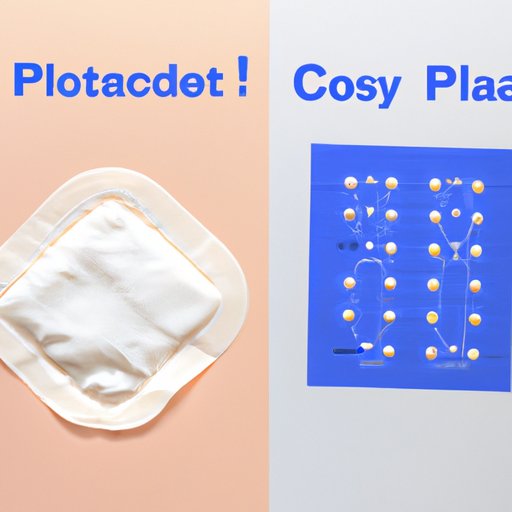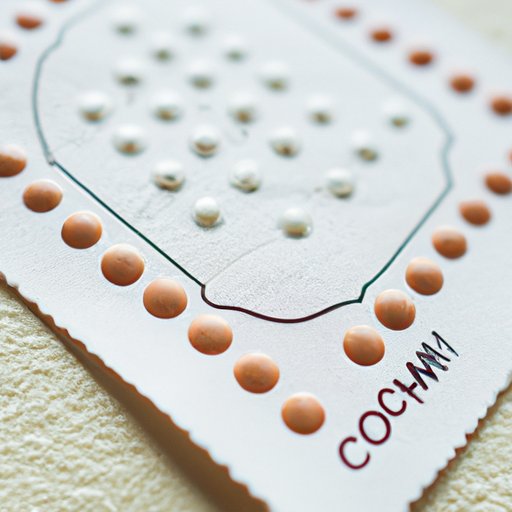Introduction
Birth control patches are a form of hormonal contraception used to prevent pregnancy. They are typically made of a thin, adhesive patch that is placed on the skin. The patch contains hormones, such as estrogen and progestin, which stop the ovaries from releasing eggs, thickens cervical mucus, and makes it more difficult for sperm to reach the uterus. This article will explore the mechanism of how birth control patches work, the various types available, their pros and cons, side effects, and how to choose the right one for you.

Explaining the Mechanism of How Birth Control Patches Work
What is a Birth Control Patch?
A birth control patch is a small, adhesive patch that is worn on the skin. It contains hormones, such as estrogen and progestin, which help to prevent pregnancy by stopping the ovaries from releasing eggs and thickening the cervical mucus, making it more difficult for sperm to reach the uterus. The patch must be changed every week, with a new patch applied on the same day of the week, usually Monday or Tuesday.
How Does it Work?
The hormones in the patch are absorbed through the skin and into the bloodstream, where they travel to the ovaries and other reproductive organs. The hormones prevent the ovaries from releasing eggs, thickens the cervical mucus, and makes it more difficult for sperm to reach the uterus. The patch does not protect against sexually transmitted infections (STIs).

Pros and Cons of Using a Birth Control Patch
Advantages of Birth Control Patches
Birth control patches have several advantages: they are convenient, easy to use, and do not require daily attention; they offer protection against pregnancy for up to three weeks; and they can reduce menstrual cramps and make periods lighter. In addition, they may also help to reduce acne, reduce the risk of pelvic inflammatory disease, and reduce the risk of some cancers, such as ovarian and endometrial cancer.
Disadvantages of Birth Control Patches
Birth control patches may cause side effects, such as nausea, headaches, and breast tenderness. In addition, they may increase the risk of blood clots, stroke, and heart attack, particularly in women who smoke or have certain medical conditions. Finally, the patch can be visible on the skin and may irritate sensitive skin.

A Breakdown of Different Types of Birth Control Patches
Ortho Evra
Ortho Evra is a brand name for the birth control patch. It is a thin, square patch that is applied to the skin once a week for three weeks. During the fourth week, no patch is worn. The patch contains both estrogen and progestin, and must be changed each week.
Xulane
Xulane is a generic version of Ortho Evra. It is a thin, square patch that is applied to the skin once a week for three weeks. During the fourth week, no patch is worn. The patch contains both estrogen and progestin, and must be changed each week.
Other Types of Birth Control Patches
In addition to Ortho Evra and Xulane, there are several other types of birth control patches available, including Evra and Mylan. Each type of patch has its own set of instructions and side effects, so it is important to talk to your doctor to determine which type is best for you.
An Overview of the Side Effects of Birth Control Patches
Common Side Effects
Common side effects of birth control patches include nausea, headaches, breast tenderness, and skin irritation. These side effects usually go away after a few days, but if they persist, it is important to speak to your doctor.
Severe Side Effects
Severe side effects of birth control patches include an increased risk of blood clots, stroke, and heart attack. Women who smoke or have certain medical conditions, such as diabetes or high blood pressure, may be at an even higher risk for these side effects, so it is important to discuss any concerns with your doctor before using a birth control patch.
How to Choose the Right Birth Control Patch for You
Consider Your Health History
Before choosing a birth control patch, it is important to consider your health history. If you have a history of blood clots, stroke, or heart attack, or if you smoke or have certain medical conditions, such as diabetes or high blood pressure, it is important to talk to your doctor before using a birth control patch.
Consult with Your Doctor
It is important to talk to your doctor about your options when it comes to choosing a birth control patch. Your doctor can provide advice on the different types of patches available, their benefits and risks, and which one may be best for you.
Conclusion
Birth control patches are a convenient and effective way to prevent pregnancy. They are easy to use and offer protection for up to three weeks. However, they may cause side effects, such as nausea, headaches, and breast tenderness, and may increase the risk of blood clots, stroke, and heart attack. It is important to talk to your doctor to determine which type of birth control patch is best for you, and to discuss any concerns you may have.
In conclusion, birth control patches offer many benefits, including convenience, effectiveness, and reduced menstrual cramps. However, it is important to consider your health history and consult with your doctor before choosing a birth control patch to ensure that it is the right option for you.
(Note: Is this article not meeting your expectations? Do you have knowledge or insights to share? Unlock new opportunities and expand your reach by joining our authors team. Click Registration to join us and share your expertise with our readers.)
